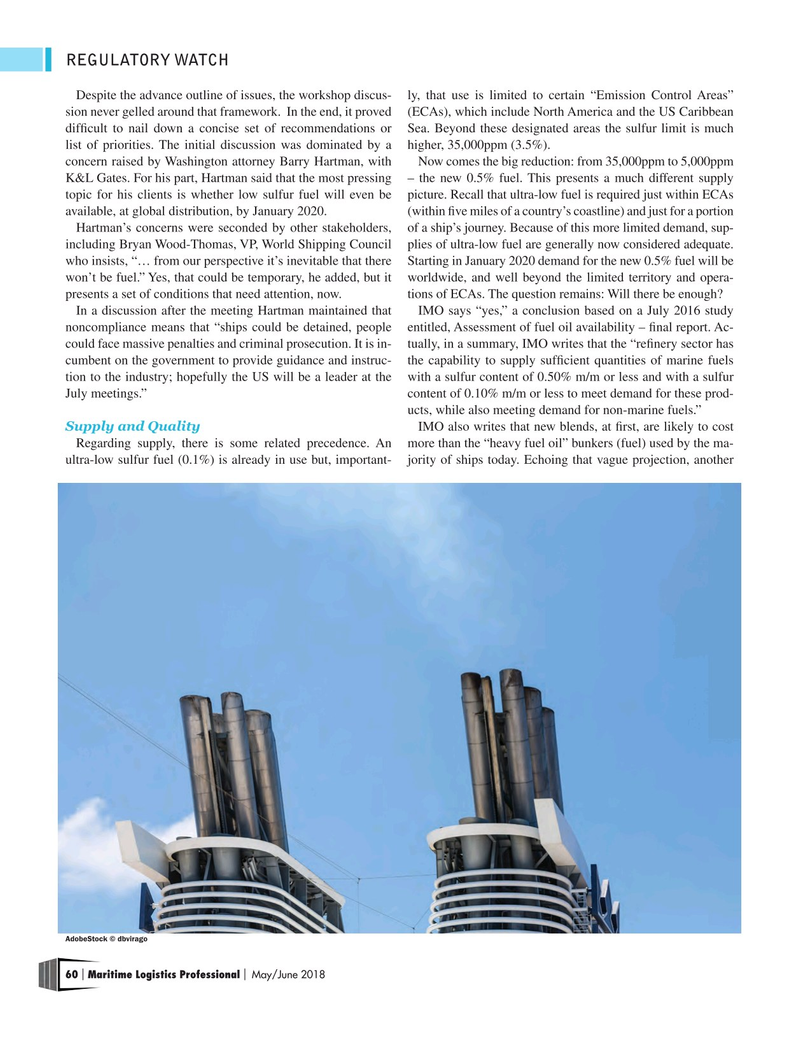
Page 60: of Maritime Logistics Professional Magazine (May/Jun 2018)
Container Ports
Read this page in Pdf, Flash or Html5 edition of May/Jun 2018 Maritime Logistics Professional Magazine
REGULATORY WATCH
Despite the advance outline of issues, the workshop discus- ly, that use is limited to certain “Emission Control Areas” sion never gelled around that framework. In the end, it proved (ECAs), which include North America and the US Caribbean diffcult to nail down a concise set of recommendations or Sea. Beyond these designated areas the sulfur limit is much list of priorities. The initial discussion was dominated by a higher, 35,000ppm (3.5%). concern raised by Washington attorney Barry Hartman, with Now comes the big reduction: from 35,000ppm to 5,000ppm
K&L Gates. For his part, Hartman said that the most pressing – the new 0.5% fuel. This presents a much different supply topic for his clients is whether low sulfur fuel will even be picture. Recall that ultra-low fuel is required just within ECAs available, at global distribution, by January 2020. (within fve miles of a country’s coastline) and just for a portion
Hartman’s concerns were seconded by other stakeholders, of a ship’s journey. Because of this more limited demand, sup- including Bryan Wood-Thomas, VP, World Shipping Council plies of ultra-low fuel are generally now considered adequate. who insists, “… from our perspective it’s inevitable that there Starting in January 2020 demand for the new 0.5% fuel will be won’t be fuel.” Yes, that could be temporary, he added, but it worldwide, and well beyond the limited territory and opera- presents a set of conditions that need attention, now. tions of ECAs. The question remains: Will there be enough?
In a discussion after the meeting Hartman maintained that IMO says “yes,” a conclusion based on a July 2016 study noncompliance means that “ships could be detained, people entitled, Assessment of fuel oil availability – fnal report. Ac- could face massive penalties and criminal prosecution. It is in- tually, in a summary, IMO writes that the “refnery sector has cumbent on the government to provide guidance and instruc- the capability to supply suffcient quantities of marine fuels tion to the industry; hopefully the US will be a leader at the with a sulfur content of 0.50% m/m or less and with a sulfur
July meetings.” content of 0.10% m/m or less to meet demand for these prod- ucts, while also meeting demand for non-marine fuels.”
Supply and Quality IMO also writes that new blends, at frst, are likely to cost
Regarding supply, there is some related precedence. An more than the “heavy fuel oil” bunkers (fuel) used by the ma- ultra-low sulfur fuel (0.1%) is already in use but, important- jority of ships today. Echoing that vague projection, another
AdobeStock © dbvirago 60 Maritime Logistics Professional May/June 2018 | |

 59
59

 61
61
